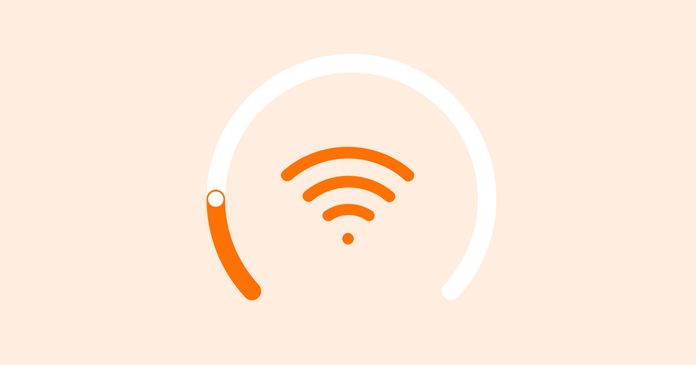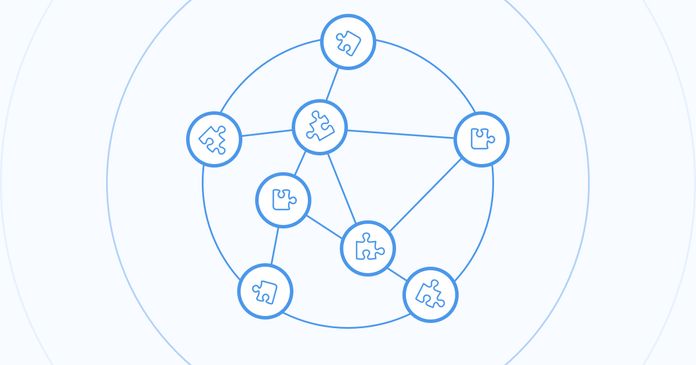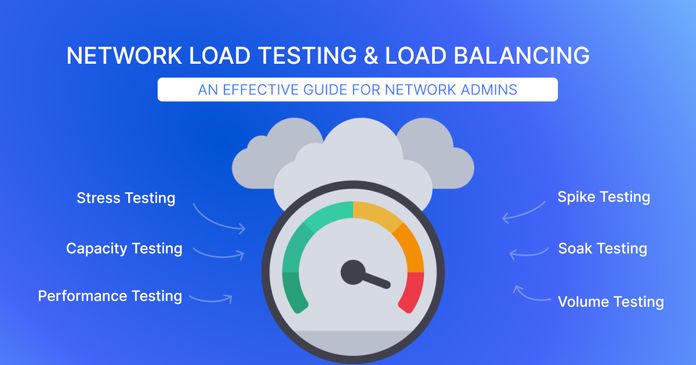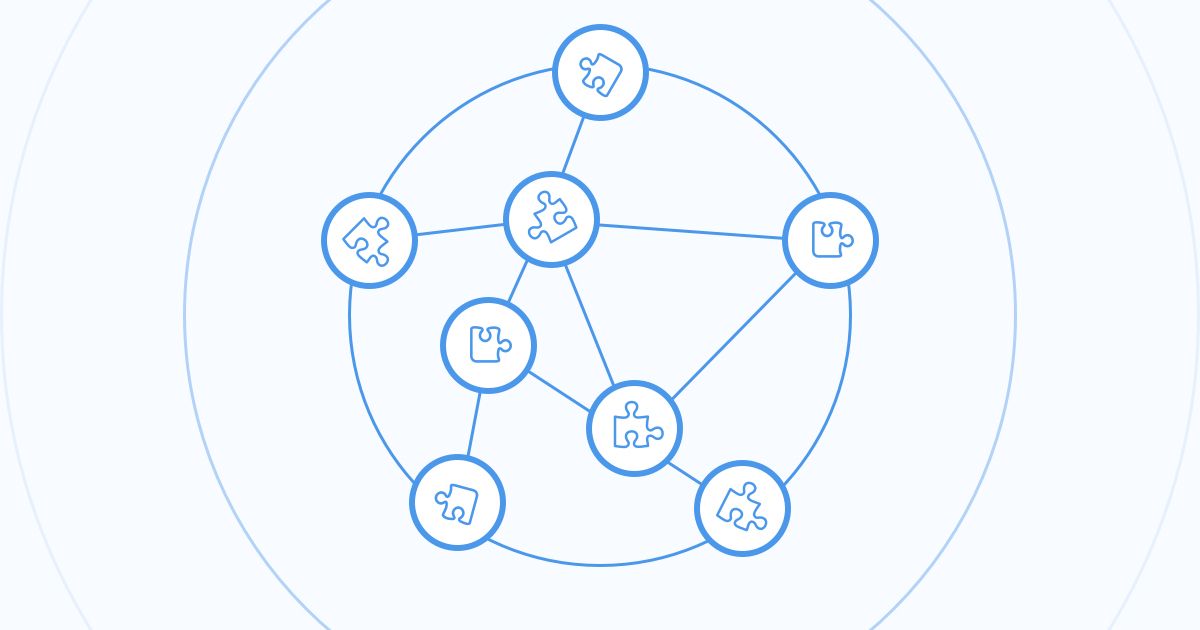Table of Contents
Table of Contents
Network overload is a modern-day nemesis we've all had to grapple with at some point. It's that heart-pounding moment when your network decides to take an unscheduled coffee break, right in the middle of that critical video conference or a major data transfer. But fear not, for this blog is your trusty guide to help you navigate the treacherous waters of network congestion with the finesse of a digital detective.
Welcome to our virtual command center, where we'll break down the art of identifying, solving, and even preventing network overload issues. Think of it as your network's personal fitness regimen – because a well-toned network is a happy network.
We'll delve into the intricacies of bandwidth, traffic management, and troubleshooting, all while keeping the conversation as breezy as a friendly chat at the water cooler. After all, even IT superheroes need a break from the tech-talk jargon from time to time. So, whether you're a seasoned IT pro looking to brush up on your network management skills or a newbie in the field trying to make sense of the networking jungle, this article has your back.
In the world of networking, network overload is the relentless adversary that lurks in the shadows of our interconnected world. But before we dive into the nitty-gritty of how to find, fix, and avoid it, let's start at the beginning and answer the most fundamental question: What exactly is network overload?
Network overload occurs when the data traffic on a network surpasses its capacity to efficiently handle that traffic. It's like trying to squeeze a gallon of water through a pint-sized funnel. The consequences can be chaotic – sluggish internet speeds, dropped connections, and disgruntled users left wondering why their favourite streaming service suddenly resembles a slideshow.
This phenomenon isn't exclusive to IT professionals; it's something that impacts all of us in this era of remote work, online gaming, and digital communication. Whether you're the tech-savvy wizard maintaining a corporate network or the everyday user experiencing a frustrating lag during a video call, understanding network overload is the first step towards regaining control.
So, think of network overload as the rush hour traffic of the digital world, and in the pages to come, we'll equip you with the tools and knowledge to navigate those congested data highways like a pro.
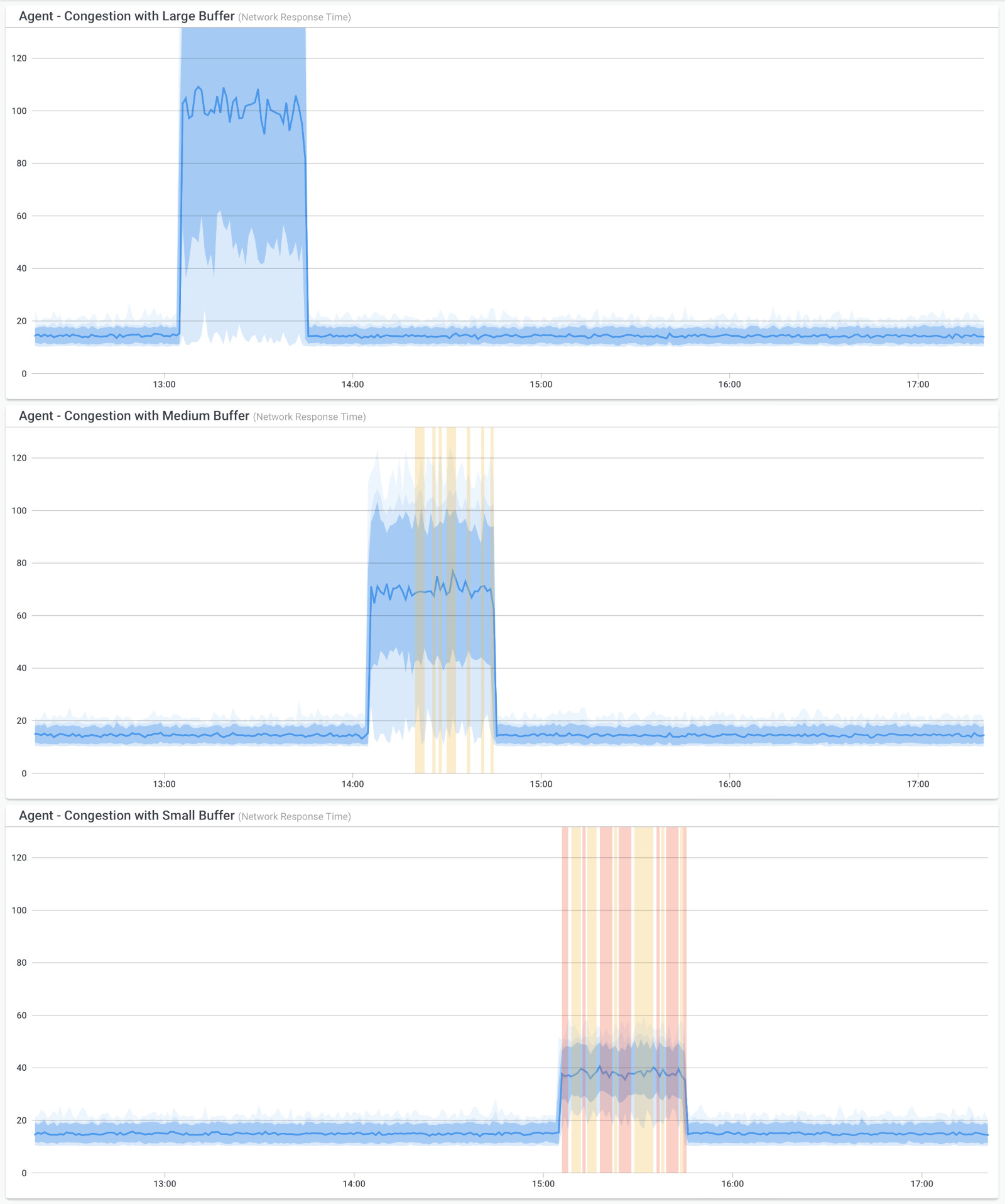

Before we get into the art of troubleshooting network overload, we’re going to roll up our sleeves and dissect the intricate anatomy of network overload. In this section, we'll break down the essential components that make up this formidable adversary, providing you with the knowledge and insights you need to conquer it.
Network overload doesn't just happen out of thin air; it's a result of specific culprits and triggers. Identifying these culprits is akin to solving a puzzle – once you know where to look, you can start putting the pieces together.
Network overload can be caused by various factors and conditions that lead to an excessive demand for network resources, ultimately exceeding the network's capacity to handle that demand efficiently. Here are some of the common causes of network overload:
- High User Traffic: A sudden surge in the number of users or devices connecting to the network can strain its resources. This often happens during events like webinars, online gaming tournaments, or significant software updates.
- Bandwidth-Intensive Applications: Applications that require significant bandwidth, such as video streaming, file downloads, or cloud backups, can consume a disproportionate share of available resources, leading to congestion.
- Misconfigured Network Devices: Errors in network device configurations, such as routers, switches, or firewalls, can lead to inefficient traffic management and contribute to network overload.
- Network Attacks: Distributed Denial of Service (DDoS) attacks can flood the network with traffic, overwhelming its capacity and causing network disruption. These attacks are often malicious and intended to disrupt services.
- Inefficient Data Routing: Poorly optimized data routing can lead to data taking inefficient paths through the network, causing congestion at certain points and leading to network overload.
- Inadequate Bandwidth Provisioning: When the network's bandwidth is not sufficient to meet the current demands, it can easily become congested, leading to performance issues.
- Background Software Updates: Automatic software updates for operating systems and applications can consume significant bandwidth, especially in organizations with numerous devices.
- Peer-to-Peer (P2P) File Sharing: P2P file-sharing applications can generate high levels of network traffic, often without any regard for network efficiency.
- Uncontrolled IoT Devices: The proliferation of Internet of Things (IoT) devices, from smart home gadgets to industrial sensors, can generate additional traffic, contributing to network congestion if not managed effectively.
- Network Bottlenecks: Some network segments may have limited capacity, creating network bottlenecks that can lead to congestion, especially if the traffic flow needs to be properly balanced.
- Inadequate QoS (Quality of Service): Without proper QoS policies in place, critical applications may not receive the priority they need, leading to network overload when demand surges.
- Network Growth and Scalability Issues: Networks that haven't scaled with the growing demands of an organization can quickly become overloaded.
Understanding these causes is essential for IT professionals and network administrators as it allows them to proactively manage and optimize their networks to prevent and address network overload effectively.
Before we embark on the journey to untangle the mysteries of network overload, it's crucial to understand the foundational concept of bandwidth. In essence, bandwidth is the data transmission capacity of your network, often measured in megabits per second (Mbps) or gigabits per second (Gbps). It's akin to the width of a pipeline, determining how much data can flow through at any given moment.
Imagine your network as a highway, with bandwidth as the number of lanes available for data to travel. Just like a multi-lane highway can accommodate more cars simultaneously, higher bandwidth allows more data to flow seamlessly. However, it's important to recognize that bandwidth isn't an infinite resource. Every network has its limits, and understanding these limits is crucial for maintaining optimal performance.
Bandwidth can come in various forms, such as dedicated, shared, or symmetrical.
- Dedicated bandwidth provides a specific amount of capacity exclusively for a single user or device.
- Shared bandwidth, on the other hand, is distributed among multiple users or devices.
- Symmetrical bandwidth offers the same upload and download speeds.
Understanding the type of bandwidth your network uses is crucial, as it influences how data flows within your network infrastructure.
How to measure bandwidth, identify issues & optimize network performance. Use Obkio's Network Performance Monitoring tool for easy bandwidth monitoring.
Learn more

Bandwidth allocation refers to the distribution of available bandwidth to various applications, services, or users. It's like managing lanes on a highway, deciding how much space each type of traffic gets.
Effective allocation ensures that mission-critical applications, like video conferencing, receive the necessary bandwidth, while less critical activities, like email or web browsing, don't monopolize resources.
Assessing whether your network's bandwidth is up to the task involves gauging your current capacity against your actual usage. It could be measuring the traffic on your highway and comparing it to the available lanes.
When traffic (data) consistently nears or surpasses the network's bandwidth limits, the likelihood of network overload increases. To ensure your network can handle the load, we'll discuss various methods for measuring and evaluating your network's bandwidth, from speed test tools to network monitoring tools.
Bandwidth, while essential for network operations, can play a significant role in network overload when it becomes a limiting factor. Network overload related to bandwidth occurs when the network's capacity to handle data traffic is exceeded, resulting in congestion and degraded performance.
Insufficient Capacity: When the available bandwidth is insufficient to accommodate the volume of data traffic on the network, congestion occurs. It's akin to trying to funnel a large volume of water through a narrow pipe – the water (data) piles up, causing a bottleneck.
High Data Demand: Bandwidth-intensive applications, such as high-definition video streaming, online gaming, or large file transfers, can consume a significant portion of available bandwidth. If multiple users or devices engage in these data-intensive activities simultaneously, the network may not have the network capacity to handle the combined demand.
Shared Resources: In shared networks, multiple users or devices have to compete for the same bandwidth. When too many users are trying to access the network simultaneously, each user's share of available bandwidth decreases, leading to slower data transfer rates and performance issues.
Network Bottlenecks: Even if the network has high overall bandwidth capacity, it can still experience overload if certain network segments or components, such as switches or routers, have limited bandwidth. Congestion can occur at these bottleneck points, affecting the entire network's performance.
Misconfigured QoS: Quality of Service (QoS) settings are used to prioritize certain types of traffic over others. Inadequate or misconfigured QoS policies can result in critical data not receiving the necessary bandwidth allocation, leading to performance degradation and network overload.
Unpredictable Traffic Spikes: Periods of unexpectedly high traffic, such as during a sudden surge in users or a significant software update, can cause network overload if the network's bandwidth capacity is not designed to handle such spikes.
Inadequate Network Provisioning: If a network's bandwidth is not provisioned to meet the current and anticipated demands, it can quickly become overloaded, particularly as the number of users and data-intensive applications grows.
Addressing network overload related to bandwidth often involves a combination of strategies, including:
- Increasing Bandwidth: Expanding the network's overall bandwidth capacity to meet current and future demands.
- Prioritizing Traffic: Implementing QoS policies to ensure critical applications receive the necessary bandwidth.
- Traffic Shaping: Managing and regulating the flow of data to prevent congestion.
- Load Balancing: Distributing traffic evenly across network resources to avoid bottlenecks.
- Network Monitoring: Using network monitoring tools to detect and address congestion in real time.
By understanding the role of bandwidth in network overload, IT professionals can take proactive measures to optimize network performance and prevent congestion-related issues.
In summary, understanding bandwidth is akin to knowing the capacity of your highway before navigating traffic congestion. By comprehending the types of bandwidth, how it's allocated, and how to evaluate its sufficiency, you'll be better equipped to make informed decisions about optimizing your network's performance.
Network overload can be a formidable challenge, but with the right tools in your arsenal, you can take control and ensure your network runs smoothly even during peak demands.
Obkio's Network Monitoring Tool is your secret weapon to detect, diagnose, and reduce network overload effectively.

With Obkio's comprehensive suite of features, you can:
- Real-Time Monitoring: Gain insights into your network's performance in real-time, allowing you to proactively address congestion and bottlenecks.
- Bandwidth Usage Analysis: Track bandwidth consumption to understand where your network's capacity is being used and optimize your bandwidth allocation.
- Measuring Network Metrics: Access detailed metrics on network metrics like, bandwidth usage, throughput, packet loss, jitter and more to make data-driven decisions for network optimization.
- Troubleshooting: Quickly identify and resolve network issues, minimizing downtime and keeping your network running smoothly.
- Quality of Service (QoS) Management: Implement QoS policies to prioritize critical applications and ensure they receive the necessary bandwidth. For example, QoS for VoIP.
- Alerts and Notifications: Receive instant network monitoring alerts when network performance starts to degrade, empowering you to take action before issues impact your users.
Ready to take the first step in ensuring a stable and efficient network? Get Started with Obkio's Network Monitoring Tool today and conquer network overload like a pro. Your network's health is just a click away!

The consequences of network overload can be far-reaching, and they often translate into one of the most dreaded scenarios in the IT world – downtime. When your network succumbs to overload, it's like a highway during a massive traffic jam – everything grinds to a halt.
Network overload can have far-reaching consequences, impacting network performance, application performance, and the overall user experience in significant ways. Here's an overview of the impact of network overload on these aspects:
- Network Congestion: Network congestion is a direct result of network overload. When the volume of data traffic exceeds the available bandwidth, it leads to congestion at various points within the network infrastructure. This congestion can result in increased latency, packet loss, and a decrease in data transfer rates.
- Reduced Throughput: Network throughput, which measures the amount of data that can be transmitted over the network in a given time, is significantly reduced during overload. Slower throughput means that data transfer and communication become sluggish, affecting all network activities.
- Dropped Connections: As network resources become strained, there is an increased likelihood of dropped connections. This can disrupt ongoing tasks, such as video calls, online gaming, or file transfers, leading to frustration and decreased productivity.
- Lag and Delays: Applications that require real-time or near-real-time data transmission, such as video conferencing, online gaming, and VoIP calls, are particularly sensitive to network overload. Users may experience lag, delays in audio and video, and a generally poor user experience when network resources are stretched thin.
- Buffering and Loading Times: Streaming services, like video and music streaming, often rely on a continuous data stream. Network overload can result in buffering, long loading times, and interruptions in content delivery, making for a frustrating viewing or listening experience.
- Decreased Responsiveness: Web-based applications and cloud services can become less responsive during network overload. Users may notice slower load times for web pages and delays in accessing cloud-hosted documents and resources.
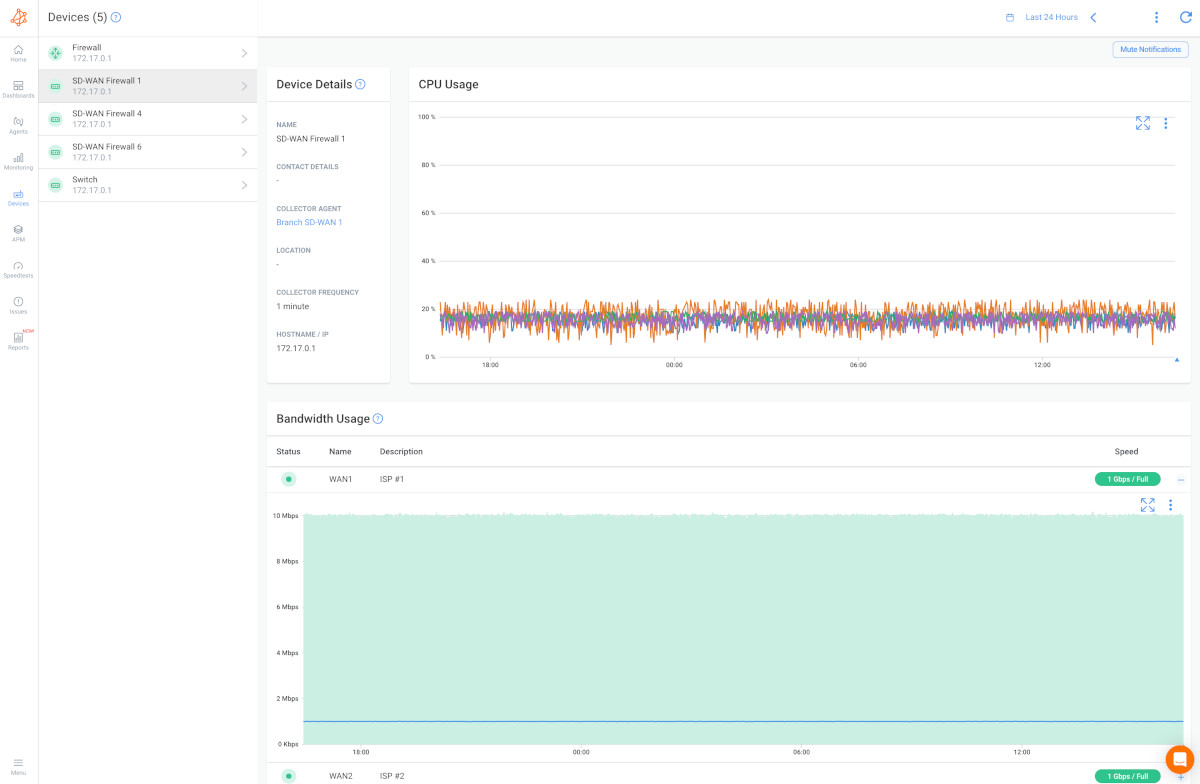
- Frustration and Productivity Loss: Users rely on efficient network and application performance for their daily tasks. When network overload disrupts these activities, frustration ensues, and productivity is compromised. In a business context, this can lead to lost time and revenue.
- Quality of Service (QoS) Issues: Quality of service, particularly in real-time communication applications, deteriorates during network overload. This can result in dropped calls, pixelated video, and distorted audio. Users may have to repeat or extend their tasks due to interruptions.
- Reputation Damage: For businesses, network overload that leads to poor user experiences can damage their reputation. Customers may perceive the business as unreliable, impacting customer trust and satisfaction.
Addressing network overload and its impact on performance and user experience is crucial for IT professionals and organizations. This involves strategies like bandwidth management, Quality of Service (QoS) implementation, network load balancing, and proactive network monitoring to ensure that the network operates smoothly even during periods of high demand.
In the world of network management, diagnosing network overload often feels like a detective's quest, and your trusty toolkit consists of network monitoring tools. These digital sleuths are your IT Sherlock Holmes kit, helping you uncover the hidden mysteries of your network's performance.
Network monitoring tools provide invaluable insights by continuously collecting data on various network parameters, such as bandwidth utilization, packet loss, latency, and more. By examining this data, you can pinpoint when and where network overload occurs, which applications or devices are responsible, and even anticipate future congestion. It's like having a magnifying glass to zoom in on the smallest clues.
To detect network overload before it affects your end-users, you need an end-to-end network monitoring tool. That’s where Obkio Network Performance Monitoring Software comes in.
Obkio provides continuous monitoring of end-to-end network performance, allowing you to assess the performance of both your local network (including LAN and VPN) and external networks (such as WAN, ISP, and Internet Peering).
Unlike conventional monitoring solutions that often focus solely on local network equipment, Obkio offers comprehensive monitoring capabilities across every aspect of your network, even in areas where you may lack IT personnel or dedicated equipment.
Obkio achieves this by utilizing synthetic traffic through Network Monitoring Agents. These agents cover all facets of your network; measuring key network metrics, detecting network issues like network overload, and collecting critical data to streamline and facilitate your troubleshooting process.

Obkio monitors network performance and identifies network overload using continuous synthetic traffic from Network Monitoring Agents deployed in key network locations like offices, data centers and clouds.
For your end-to-end network performance monitoring setup, you’ll need the following Monitoring Agents (which Obkio’s Onboarding Wizard with help you deploy):
- Local Agents: Installed in the targeted office location where you want to detect network overload and monitor network performance. There are several Agent types available (all with the same features), and they can be installed on MacOS, Windows, Linux and more.
- Public Monitoring Agent: These are deployed over the Internet and managed by Obkio. They compare performance up to the Internet and quickly identify if the problem is global or specific to the destination. For example, detect network overload between your branch office and Google Cloud.
The Agents monitor network bandwidth, as well as other key network metrics to detect network overload by sending and monitoring synthetic traffic through your network every 500ms for the most precise network performance measurements.
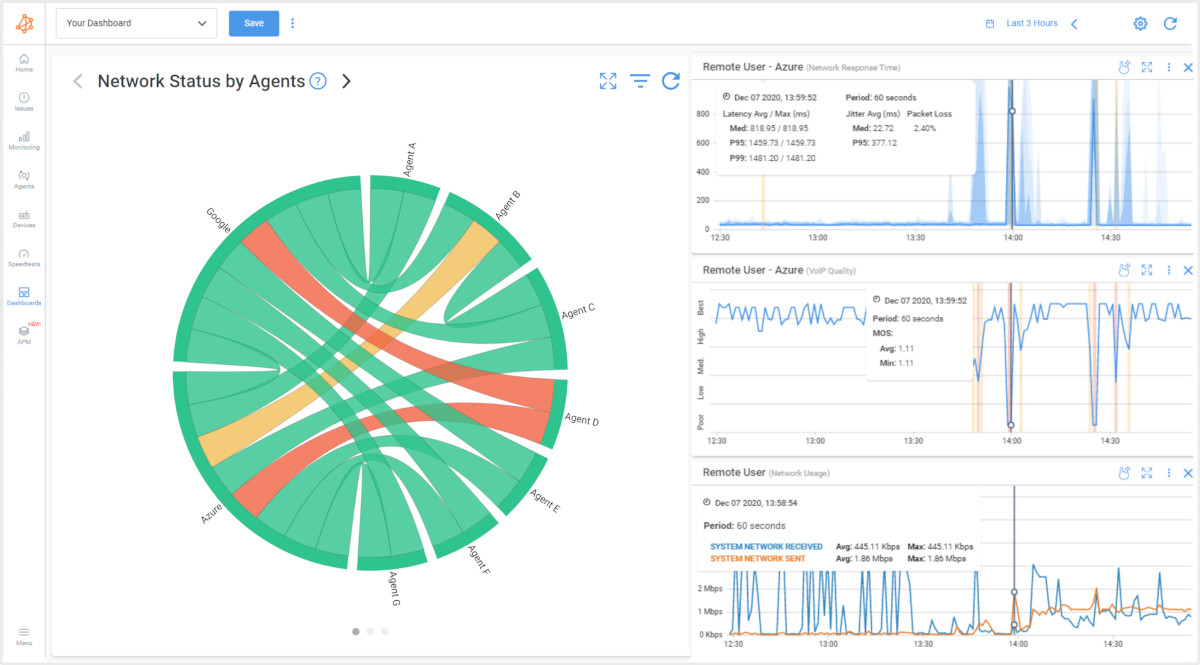
While it's easy to spot network overload when it occurs within your network equipment, the reality is that you're not always relying solely on your own gear. Many businesses utilize network equipment provided by their ISPs or managed service providers (MSPs), which means direct access to the equipment's data isn't always at your fingertips.
Moreover, network overload might not necessarily be confined to your own network; it could be occurring within your ISP's network, on the local loop of its connection, or even further along the Internet's pathways. However, fear not, as it's still entirely feasible to identify network overload by keeping a watchful eye on other critical network metrics!
To effectively detect network overload, you should monitor a combination of network metrics that provide insights into different aspects of network performance, such as:
- Bandwidth Utilization: Bandwidth utilization measures the percentage of available bandwidth being used. A sudden and sustained increase in bandwidth utilization can be an early indicator of network overload.
- Packet Loss: Packet loss occurs when data packets are dropped during transmission. An elevated packet loss rate can indicate congestion or network issues that need attention.
- Latency: Latency, often measured through ping times, represents the delay in data transmission. High latency can lead to network congestion and affect real-time applications like video conferencing and online gaming.
- Jitter: Jitter measures the variation in latency between data packets. Consistently high jitter can disrupt real-time communications and affect the quality of service.
- Network Traffic Patterns: Analyzing traffic patterns helps you understand how data flows within your network. Sudden spikes or unusual patterns can signify network overload.
- Quality of Service (QoS) Metrics: Monitoring QoS metrics, such as DSCP markings or traffic classification, can help ensure that critical applications receive the necessary priority and bandwidth.
- Throughput: Throughput measures the actual data transfer rate in the network. A significant decrease in throughput can signal congestion and overload.
- Network Errors and Discards: Monitoring for network errors and discarded packets can provide insights into the health of network interfaces and the occurrence of congestion.
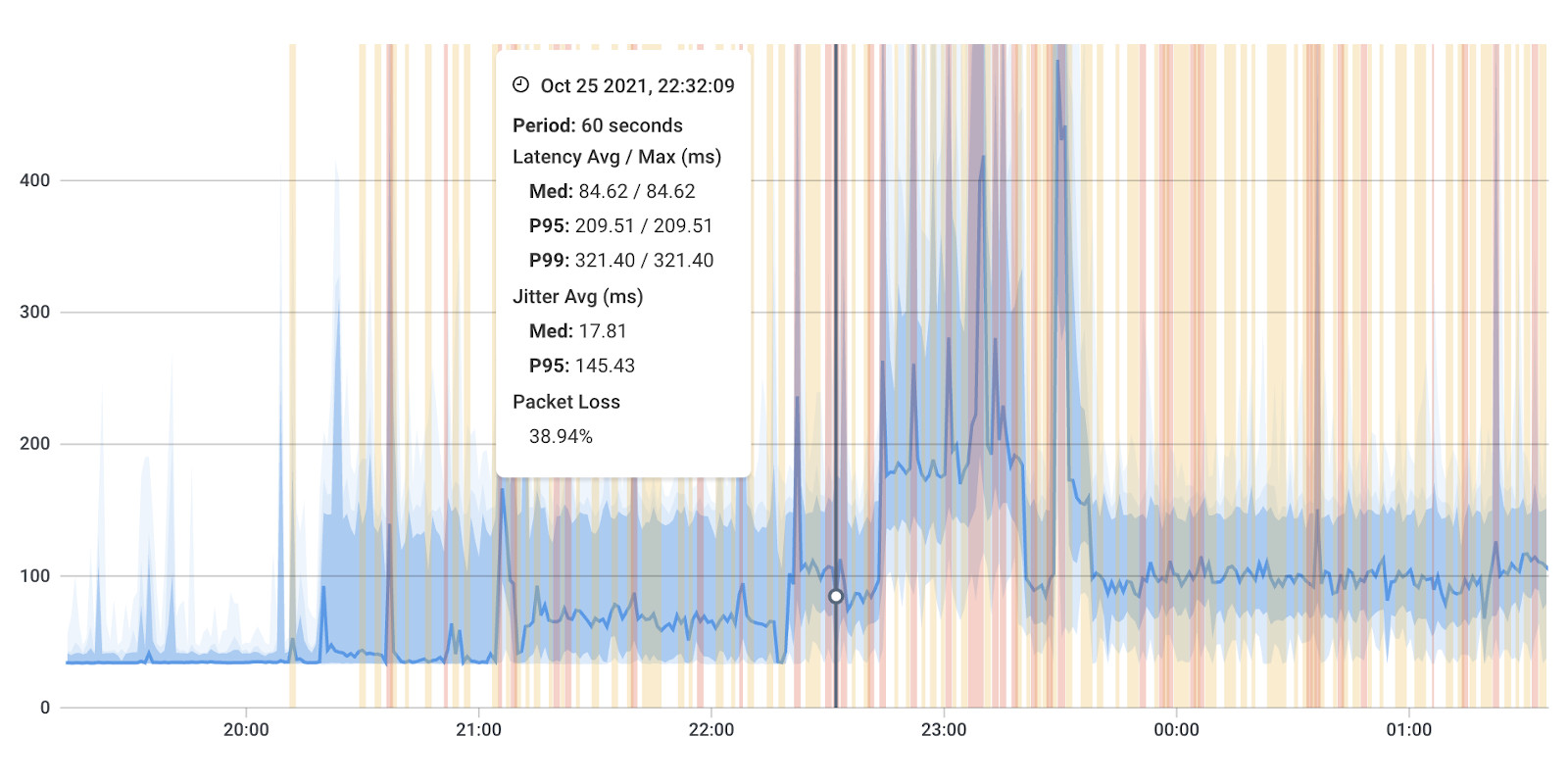
By continuously monitoring these network metrics, you can gain a comprehensive view of your network's health, promptly identify potential issues, and take proactive measures to prevent or mitigate network overload. Network monitoring tools and software can assist in collecting and analyzing these metrics effectively.
In addition to monitoring network performance as a whole, monitoring network devices is also important for detecting network overload. Network devices, such as routers, switches, and firewalls, play a critical role in the functioning of your network.
Network devices can become bottlenecks when they are overwhelmed with traffic. Monitoring their performance metrics, such as CPU usage and memory utilization, can help you pinpoint when a device is under stress and contributing to network congestion.
Obkio’s Network Device Monitoring feature is a fast and easy solution to get detailed information about the performance of your core network devices using SNMP polling to quickly and proactively pinpoint and troubleshoot network device issues like congestion, and high CPU and interface errors.
Detect Misconfigurations: Errors or misconfigurations in network devices can lead to inefficient traffic routing and network issues. Monitoring devices can help you identify these misconfigurations, allowing you to rectify them promptly.
Track Device Health: Regular monitoring of network devices helps ensure they are operating optimally. Any hardware failures or malfunctions can be detected early, preventing unexpected network disruptions.
Manage Traffic Flow: Network devices are responsible for managing traffic flow within your network. Monitoring them helps in understanding how devices are handling the data, which is crucial for optimizing network performance.
Load Balancing: Network devices can be configured to distribute traffic load effectively. Monitoring load balancers allows you to ensure that traffic is balanced evenly across resources, reducing the risk of overload.

To effectively detect network overload, several network devices are important to monitor, along with their corresponding metrics. Here's a list of key network devices and the relevant metrics to track:
1. Routers:
- Bandwidth Utilization: Monitor the percentage of available bandwidth in use.
- Latency: Measure the delay in data transmission.
- Packet Loss: Keep an eye on the rate of dropped data packets.
2. Switches:
- Throughput: Monitor data transfer rates within the switch.
- Error Rates: Track the number of errors in data transmission.
- Port Utilization: Check the usage levels of individual switch ports.
3. Firewalls:
- CPU and Memory Utilization: Monitor the device's resource usage, as high utilization can lead to reduced performance.
- Connection Counts: Keep track of active connections to ensure the firewall can handle the load.
4. Load Balancers:
- Throughput: Measure the data transfer rate through the load balancer.
- Session Counts: Track the number of active sessions or connections handled by the load balancer.
5. Gateways:
- Latency: Monitor the delay in traffic routing.
- Bandwidth Utilization: Keep an eye on bandwidth usage at the gateway.
6. Access Points (for Wireless Networks):
- Signal Strength: Ensure that signal strength is within acceptable levels to prevent interference and packet loss.
- Interference Levels: Monitor for interference from other wireless devices or sources.
7. ISP Equipment:
- Bandwidth Utilization: Monitor the usage of the Internet connection provided by your ISP.
- Latency: Measure the latency introduced by the ISP's network.
8. Network Interfaces (e.g., Network Cards):
- Error Rates: Track errors on network interfaces.
- Throughput: Measure data transfer rates for specific interfaces.
These network devices and their associated metrics provide a comprehensive view of your network's health and performance. Monitoring these devices allows you to detect congestion, bottlenecks, and other issues that may lead to network overload.
In a world where network overload can happen swiftly and unexpectedly, real-time alerts serve as your network's watchful guardian. They detect issues like unusual spikes in bandwidth usage, sudden increases in latency, or packet loss and send out alerts in real-time. These alerts ensure that you're always one step ahead, ready to act quickly to avert network disasters.
Obkio continuously monitors network performance metrics, such as bandwidth utilization, latency, packet loss, and more, in real-time. These metrics provide a clear picture of how your network is operating at any given moment.
Obkio allows you to set specific thresholds for each monitored metric. These thresholds act as predefined limits that, when exceeded, trigger real-time alerts. For example, you can set a threshold for bandwidth utilization at 90%, which means that if the network usage exceeds 90% of the available bandwidth, an alert will be triggered.
When a metric surpasses its defined threshold, Obkio sends immediate notifications to designated users or teams via email, webhooks, or other preferred communication methods. With real-time alerts, you can respond proactively to network overload situations. When an alert is triggered, you can investigate the cause, whether it's bandwidth-hungry applications, misconfigurations, or increased traffic volume. This enables you to take immediate action to mitigate congestion and prevent further issues.
By detecting network overload in its early stages, Obkio's alerts help prevent network downtime and associated business disruptions. This proactive approach ensures that your network remains resilient and can continue to meet the demands of users and critical applications.


Detecting network overload often involves playing the role of a detective, seeking out clues in the form of traffic patterns. Much like how detectives analyze patterns of criminal behaviour to predict and prevent crimes, understanding the intricate tapestry of data flow within your network is the key to solving the network overload mystery.
Traffic Flow Analysis: Collecting traffic data begins with understanding how data moves within your network. To capture these digital footprints, you can employ network monitoring tools and software that track the flow of data packets. This analysis paints a vivid picture of data paths, destinations, and volumes.
Packet Capture: For a more granular view, packet capture tools enable you to capture individual data packets, providing a microscopic look at the content and behaviour of network traffic. Packet capture is indispensable for in-depth troubleshooting and forensic analysis.
Flow Records: Flow records, such as NetFlow and sFlow, provide aggregated data on network flows. These records summarize traffic information, including source and destination IP addresses, ports, and protocols, making it easier to analyze large datasets efficiently.
1. Identifying Usage Trends:
With data in hand, you can begin identifying usage trends within your network. Peak usage times, the most data-hungry applications, and common data destinations become apparent. This knowledge guides you in resource allocation and network optimization.
2. Detecting Anomalies:
Beyond trends, your skill in traffic data interpretation allows you to spot anomalies. Sudden spikes in traffic, unusual data patterns, or significant deviations from the norm serve as red flags for potential congestion or network issues.
3. Investigating the Causes:
Armed with data interpretation skills, you can delve deeper to uncover the underlying causes of network overload. Is it a bandwidth-hungry application hogging resources, a misconfiguration, or external traffic flooding your network? Data interpretation unveils these culprits.
Traffic Shaping:
Once you've identified the areas of concern, you can proactively manage network traffic by implementing traffic-shaping policies. Prioritize critical applications, allocate bandwidth effectively, and ensure that the most essential data flows smoothly.
Quality of Service (QoS) Implementation:
By leveraging QoS policies, you can guarantee that high-priority traffic receives preferential treatment. This is crucial for real-time applications like VoIP and video conferencing, as it helps prevent disruptions due to network overload.
Load Balancing:
Efficiently distributing traffic across network resources, such as multiple servers or links, can help prevent congestion and overload. Load balancing ensures that no single resource is overwhelmed.
Network Expansion and Optimization:
Data interpretation also guides network expansion and optimization efforts. It helps you determine when to add additional bandwidth or upgrade network equipment to meet growing demands.
In conclusion, collecting and interpreting traffic data is a fundamental skill for network management professionals. It allows you to understand network usage, detect anomalies, investigate the root causes of overload, and take proactive measures to maintain a network that operates at peak performance.
Learn how to detect network congestion & perform a network congestion test inside & outside your network with Network Monitoring & Network Device Monitoring.
Learn more

To unveil the secrets hidden within your network and develop a strategy to combat overload, you need a powerful investigative tool: the network overload test.
This section explores the art of network overload testing, providing you with the knowledge and skills to confront the challenges head-on. We will dive deep into the concept of network overload testing, defining what it entails and how it can fortify your network's resilience. We will also guide you through the intricate process of conducting a network overload test, step by step, unveiling the secrets that lie within your network infrastructure.
A network overload test is a deliberate and controlled examination of your network's capacity and performance under extreme conditions. It's like stress-testing a bridge to ensure it can withstand the heaviest of loads without collapsing. In the world of network management, this test allows you to assess how your network copes when pushed to its limits, helping you identify vulnerabilities and prepare for real-world scenarios where overload might occur.
Conducting a network overload test is a strategic process that requires careful planning and execution. Here's a step-by-step guide on how to perform such a test:
Step 1. Define Network Overload Test Objectives and Scenarios:
Begin by defining the objectives of the test. What do you aim to achieve? Are you testing the network's maximum capacity, its ability to handle a sudden traffic surge or its performance under specific conditions?
Create realistic scenarios that mimic potential real-world overload situations. For example, simulate a sudden increase in user activity, a massive data transfer, or a surge in application usage.
Step 2. Select Network Overload Test Tools:
Choose the right tools and software to generate synthetic traffic and monitor network performance during the test. Network traffic generators and Network Monitoring tools, like Obkio, are essential for this purpose.
For network overload tests, synthetic testing is a preferable technique, since it allows you to detect network overload in a controlled environment, and without requiring actual user traffic. This means that you can detect network overload during off-hours when users aren’t accessing the network.

Step 3. Set Up the Network Overload Test Environment:
Isolate the test environment from the production network to avoid causing disruptions. Use a test network or a dedicated lab setup for the experiment.
Ensure that all hardware and software configurations are consistent with your production network to make the results relevant.
Step 4. Generate Synthetic Traffic:
Start the test by generating synthetic traffic that mimics the defined scenarios. This can involve generating large data transfers, mimicking user activities, or introducing various types of network traffic.
Gradually increase the traffic load to observe how the network responds. Keep an eye on key metrics such as bandwidth utilization, latency, and packet loss.
Obkio’s Network Monitoring tool uses synthetic monitoring to measure network performance and identify issues, so you can just deploy Obkio to perform this step.
Step 5. Monitor and Analyze Network Performance:
Use Obkio’s network monitoring tool to collect real-time data on network performance during the test. Monitor critical metrics, and be prepared to analyze the results as the test progresses.
Pay attention to any signs of network congestion, performance degradation, or other network issues that indicate overload.
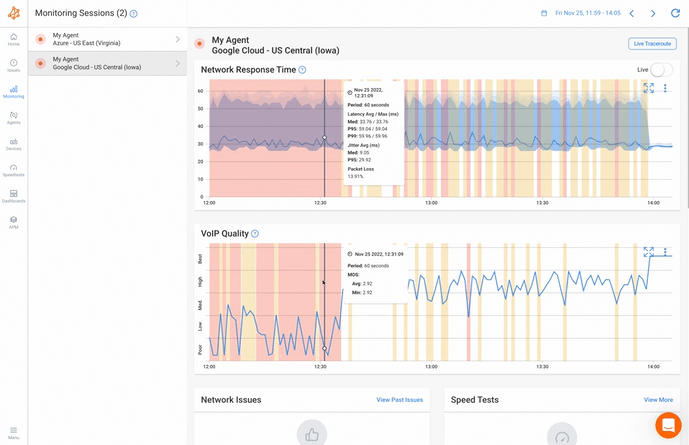

Step 6. Measure and Document Results:
Measure how the network handles the increased traffic load and document the results. Compare the observed performance with your predefined objectives and expectations.
Note any bottlenecks, points of failure, or areas where network performance falls below acceptable levels.
Step 7. Refine and Optimize:
Based on the test results, make necessary adjustments to your network configuration, hardware, or policies to address the identified weaknesses.
Use the test findings to optimize your network for better performance and resilience against network overload in the future.
Step 8. Repeat and Validate:
Network overload tests should be conducted periodically to validate the improvements and ensure your network remains robust and resilient. Regular testing helps you stay prepared for evolving network demands and potential overload situations.
If you’re using a Network Monitoring tool, like Obkio, to perform these steps, you don’t have to worry about repeating them manually. Obkio continuously monitors and tests network performance so you don’t have to.
By conducting network overload tests, you gain valuable insights into your network's behaviour under stress, helping you identify weaknesses and develop strategies to prevent and manage overload effectively. This proactive approach ensures that your network remains reliable, even in the face of unexpected challenges.
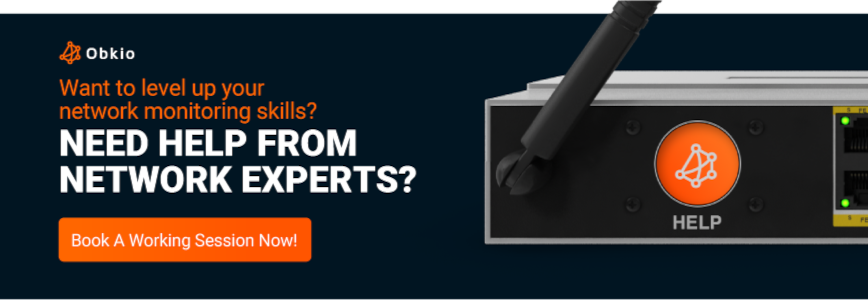
In the world of network management, two terms often take center stage: "network overload" and "network capacity overload." While they might sound similar, these concepts have distinct implications that every IT professional should be aware of.
In this section, we aim to clarify the differences between network overload and network capacity overload. This understanding is essential for troubleshooting network issues effectively. By the end of this discussion, you'll have a clear grasp of when your network is simply overwhelmed with traffic and when its underlying resources are insufficient to handle the load.
So, let's dive in and decode the intricacies of network overload and capacity overload to equip you with the knowledge needed to keep your network running smoothly in various challenging scenarios.
Network overload, also known as congestion, occurs when the volume of traffic on a network exceeds its designed or available capacity to handle that traffic efficiently. This can include WAN or LAN congestion.
Causes: Network overload can result from various factors, such as a sudden surge in user activity, bandwidth-intensive applications, misconfigurations, or unexpected spikes in data transfer.
Impact: When network overload occurs, it can lead to degraded performance, increased latency, packet loss, and, in severe cases, network outages. This can disrupt the normal functioning of applications and services, affecting user experience and productivity.
Network capacity overload specifically refers to a situation where the network's physical or available network capacity, such as its bandwidth or processing power, is insufficient to handle the existing traffic load.
Causes: Capacity overload typically occurs when network resources have reached their limits due to factors like insufficient bandwidth, underpowered hardware, or an outdated network infrastructure.
Impact: The consequences of capacity overload are similar to network overload, including performance degradation, latency, packet loss, and service interruptions. The key distinction is that capacity overload is related to resource limitations.
In essence, network overload is a broader term that encompasses situations where the network is struggling to cope with the volume of traffic, whether that's due to high user demand, resource limitations, or other factors.
Network capacity overload, on the other hand, is a specific instance of network overload where the root cause can be traced back to inadequate network capacity or resources. Identifying the cause of overload, whether it's capacity-related or not, is crucial for implementing effective solutions to ensure smooth network operations.
Discover the power of Network Capacity Monitoring and network Capacity Planning. Understand how and why to monitor and optimize network capacity.
Learn more

Network overload can strike at any moment, disrupting operations and hampering productivity. To mitigate its impact and ensure uninterrupted network performance, you need real-time solutions that can adapt to changing circumstances.
In this section, we explore three key strategies to reduce network overload as it happens, ensuring your network remains robust and resilient.
Quality of Service, or QoS, is your network's traffic cop, directing data based on its importance and ensuring that critical applications receive the necessary priority. With QoS, you can categorize and prioritize traffic, guaranteeing that latency-sensitive services like VoIP or video conferencing maintain a seamless experience.
During periods of high network activity, QoS ensures that mission-critical traffic isn't left stuck in a traffic jam. This dynamic allocation of resources is akin to clearing the path for emergency vehicles in a crowded city – vital services reach their destination swiftly, even during rush hour.
Load balancing is your network's equilibrium-keeper, distributing traffic evenly across multiple resources. This technique prevents any single resource from being overwhelmed, reducing the risk of network congestion.
Load balancers monitor the health and performance of servers or network links, ensuring that they are always operating optimally. When one resource experiences a surge in demand, load balancing redirects traffic to other available resources, maintaining a balanced workload across the network. Think of it as distributing weight evenly across a bridge, ensuring that no single segment is strained beyond its limits.
Explore the world of network administration with insights on network load testing, network load balancing, and the role of NPM. Optimize your network today!
Learn more

Traffic shaping techniques act as your network's speed limit signs, regulating the flow of data to prevent sudden surges that can lead to congestion. By shaping traffic, you can smooth out network utilization, preventing data floods and ensuring a steady and consistent flow.
This not only reduces the risk of overload but also enhances user experience by preventing packet bursts that can disrupt services. Traffic shaping is like introducing roundabouts to control traffic flow in a busy intersection, preventing gridlock and maintaining the steady movement of vehicles.
Incorporating these strategies into your network management toolkit empowers you to handle network overload in real-time. Whether it's giving priority to critical applications, distributing workloads evenly, or maintaining steady traffic flow, these approaches ensure that your network remains resilient even during the most challenging moments. With these tools at your disposal, you're well-prepared to keep network overload at bay and provide uninterrupted service to users and applications.
Learn to use network optimization and monitoring to optimize network performance, improve your end-user experience, and compare performance from the past.
Learn more

In the world of network management, the best way to deal with network overload is to prevent it from happening in the first place. This chapter explores key strategies and preventive measures that can help you safeguard your network's health and prevent overload scenarios.
Effective network capacity planning is like selecting the right-sized vehicle for a long road trip. It ensures that your network has the resources it needs to handle current and future demands. Capacity planning involves:
- Traffic Forecasting: Predicting the growth in network traffic and usage patterns, allowing you to allocate resources appropriately.
- Scaling Resources: Scaling up network bandwidth, hardware, and other resources to accommodate growing demands.
- Regular Evaluation: Continuously assessing your network's capacity and making adjustments as needed.
By right-sizing your network through capacity planning, you can avoid many overload situations before they occur.
Network configurations are the blueprints of your digital infrastructure, and efficient blueprints lead to efficient operations. Optimization involves:
Streamlining Network Paths: Reducing unnecessary detours or loops in the network's traffic paths to minimize latency and congestion.
Quality of Service (QoS): Implementing QoS policies to prioritize critical traffic and ensure it gets the necessary bandwidth.
Regular Audits: Conducting periodic network audits of network configurations to identify and eliminate bottlenecks or inefficiencies.
Optimized network configurations ensure that traffic flows smoothly, reducing the risk of overload.
A secure network is a robust network. Network security measures are essential for protecting your network from malicious attacks and the potential for overload due to security breaches. These measures include:
- Firewalls: Implement firewalls to filter incoming and outgoing traffic and prevent unauthorized access.
- Intrusion Detection and Prevention Systems (IDPS): Using IDPS to identify and mitigate threats in real-time.
- Regular Updates: Keeping network security devices and software up-to-date to address vulnerabilities and exploits.
By fortifying your network's security, you not only protect against attacks but also prevent security-related overload situations that could compromise network performance.
In conclusion, preventing network overload requires a proactive approach that encompasses capacity planning, network optimization, and robust security. These measures help ensure that your network remains resilient, efficient, and capable of handling the demands of your users and applications without succumbing to overload scenarios. By implementing these preventive measures, you can maintain a network that operates smoothly and reliably.
Throughout this guide, we've ventured into the complexities of network overload and capacity issues, unravelled the mysteries of network traffic patterns, and discovered many strategies to detect, prevent, and mitigate overload scenarios. Here are the key takeaways:
- Distinguishing Network Overload: Understand the difference between network overload and capacity overload, as recognizing the root cause is essential for effective solutions.
- Real-Time Overload Management: Deploy Quality of Service (QoS) to prioritize traffic, load balancing to distribute workloads, and traffic shaping to maintain steady traffic flow, ensuring a network that can adapt on the fly.
- Preventive Measures: Implement capacity planning to right-size your network, optimize network configurations, and bolster security measures to protect against threats that can lead to overload.
Armed with these insights, you're now better prepared to maintain a resilient network capable of navigating the often unpredictable digital landscape.

In the modern world of network management, having the right tools can make all the difference. Obkio’s Network Monitoring tool is your trusty partner in the battle against network overload!
- Real-Time Monitoring: Obkio continuously tracks network performance in real-time, providing you with insights into bandwidth utilization, latency, and packet loss.
- Threshold Alerts: Obkio's threshold-based alerts keep you informed when network metrics exceed predefined limits, allowing you to respond proactively to potential overload situations.
- Synthetic Traffic Generation: By simulating network traffic, Obkio's agents can help you assess your network's behaviour under controlled conditions, including overload scenarios.
- Capacity Planning: Obkio's insights into network performance enable better capacity planning, ensuring you're always prepared for future demands.
With Obkio as your network monitoring companion, you have the tools and insights you need to keep your network running smoothly and efficiently. It's your digital compass, helping you navigate the complex terrain of network overload with confidence.
In closing, your network is your control center, and with the right strategies and tools in place, you can steer it through any challenge that comes your way. Embrace the power of knowledge and technology, and ensure that your network remains a well-oiled machine, keeping your organization's operations on the road to success.



























 Obkio Blog
Obkio Blog



